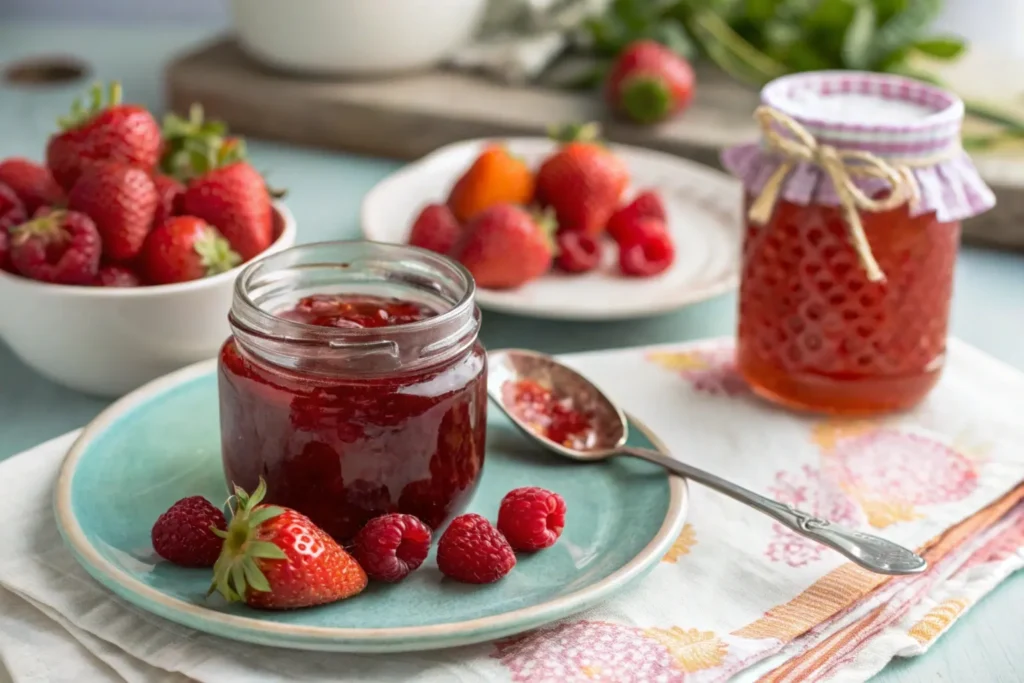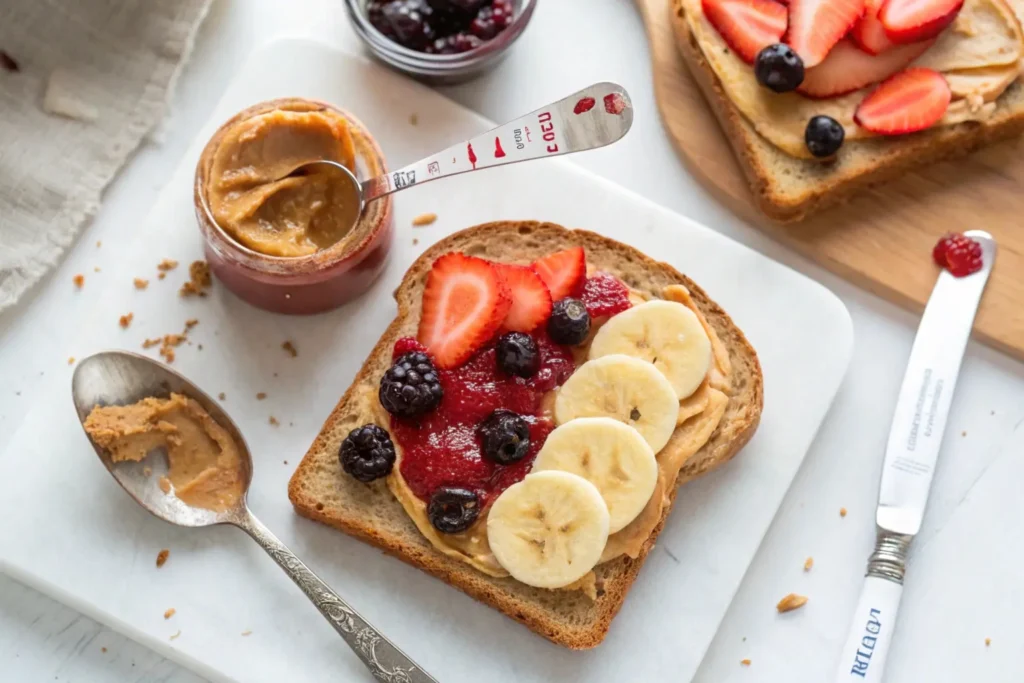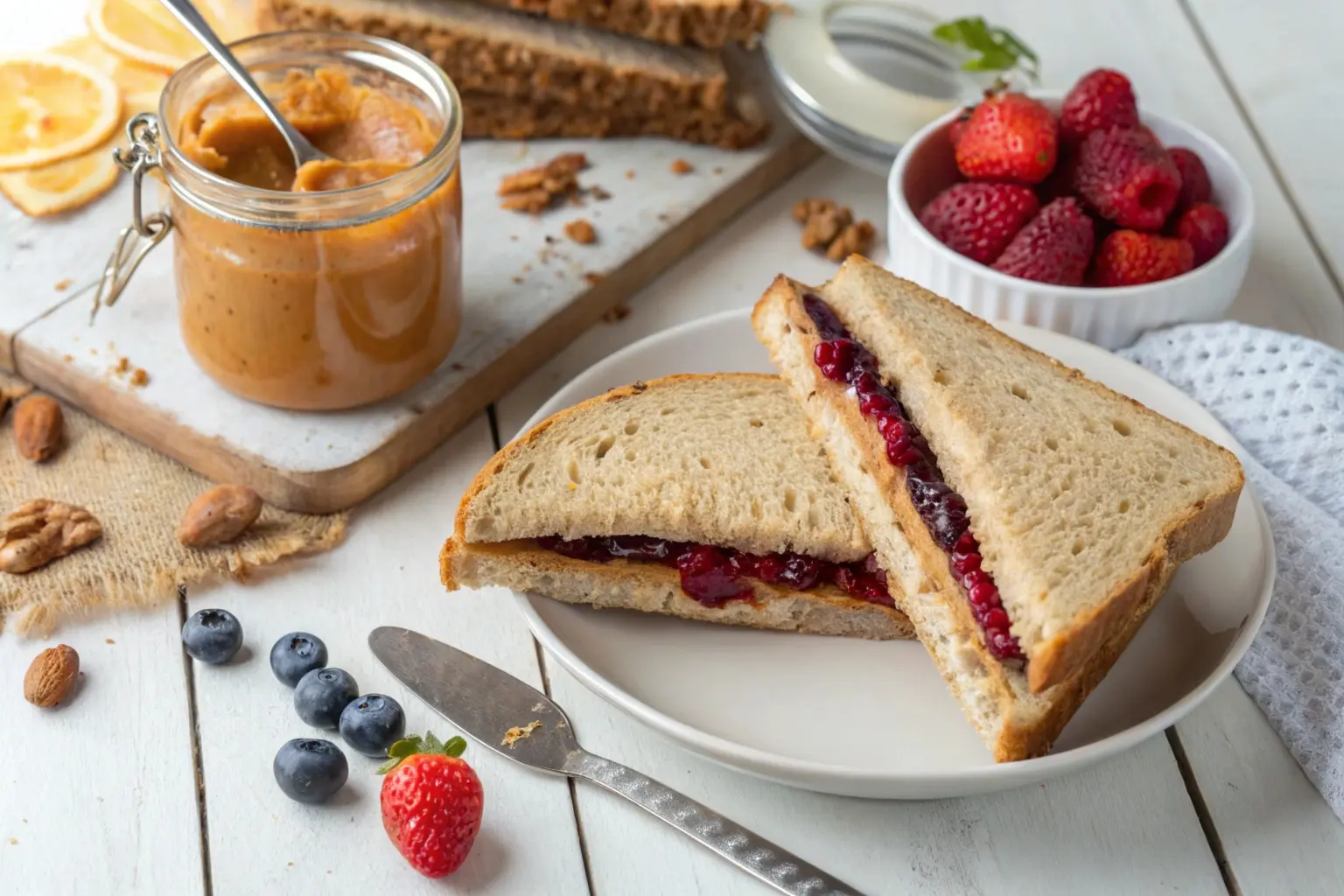Peanut butter and jelly sandwiches are a beloved classic, enjoyed by people of all ages. Whether it’s a quick snack, a school lunch, or a nostalgic indulgence, PB&J offers a perfect balance of sweetness and savory flavors. However, for those mindful of their diet, a common question arises: How many calories for 2 slices of bread with peanut butter and jelly?
In this article, we’ll break down the calorie count of each ingredient, explore how bread choices and spread types can affect nutrition, and provide tips for making a healthier PB&J. Let’s dive into the numbers and find out how this sandwich fits into your daily calorie goals.
Table of Contents
Breaking Down the Ingredients
Caloric Content of Peanut Butter
Peanut butter is undeniably the star of the PB&J show, but it’s also calorie-dense. Just one tablespoon of peanut butter contains around 95–100 calories. While packed with protein and healthy fats, the calorie count can quickly add up if you’re not mindful of portion sizes.
Most peanut butters also contain added sugar and salt, which contribute to the flavor but may impact overall nutrition. Opting for natural peanut butter made solely from peanuts can cut unnecessary additives while maintaining the creamy texture and rich taste you love.
Jelly Calories: What Adds Sweetness?
The jelly layer in your PB&J is what brings the sweetness to the table. Typically, one tablespoon of jelly has about 50 calories, with most of those coming from sugar. While traditional jelly adds a delightful fruity flavor, it’s worth noting that low-sugar or fruit-only alternatives contain fewer calories and still satisfy your sweet tooth.
Bread: White, Whole Grain, or Multigrain
Your bread choice plays a significant role in determining the total calorie count of your sandwich. Two slices of white bread typically add about 140 calories, while whole grain or multigrain bread averages around 160 calories for the same portion. Though slightly higher in calories, whole grain bread offers more fiber and nutrients, making it a healthier option overall.
By understanding the calorie content of peanut butter, jelly, and bread, you can see how each element contributes to the final number.
Calculating Calories for PB&J Sandwich
Typical Caloric Range for a PB&J Sandwich
So, how many calories for 2 slices of bread with peanut butter and jelly? The answer depends on the ingredients you choose and their portions. On average, a PB&J sandwich made with two slices of white bread, two tablespoons of peanut butter, and one tablespoon of jelly contains about 350–400 calories.
- Bread: Two slices of white bread contribute approximately 140 calories. If you opt for whole grain or multigrain bread, this increases slightly to around 160 calories.
- Peanut Butter: Two tablespoons of regular peanut butter add roughly 190 calories. Natural peanut butter, with fewer added sugars and oils, has a similar calorie count but offers better nutritional value.
- Jelly: One tablespoon of jelly contributes about 50 calories, primarily from sugar. Low-sugar or fruit-only jellies reduce this to 30–40 calories.
Combining these ingredients, your sandwich totals between 350 and 400 calories, depending on your choices. If you add extra peanut butter or jelly, or use thick slices of bread, the calorie count rises quickly.
How Bread Choice Impacts Calories
Your choice of bread can make a noticeable difference in the total calories of your PB&J. White bread, while lower in calories, is also less nutritious compared to whole grain or multigrain options. Whole grain bread not only adds more fiber but also contributes essential nutrients like B vitamins and minerals.
For a lighter option, you might consider using thin-sliced bread, which reduces the calorie count by around 30–40 calories per slice. Alternatively, using only one slice of bread to make an open-faced PB&J can significantly cut calories while keeping the same delicious flavors.
With a better understanding of the calorie breakdown, let’s explore the health benefits of a PB&J sandwich in the next section.
Health Benefits of a PB&J Sandwich
Protein and Energy from Peanut Butter
Peanut butter is more than just a tasty spread—it’s a powerhouse of nutrition. It’s packed with protein, healthy fats, and essential vitamins like vitamin E and magnesium. These nutrients provide long-lasting energy, making PB&J a great snack or meal for active individuals.
One of the best things about peanut butter is its ability to keep you full. Protein and fat slow digestion, helping you feel satisfied longer. This makes it an excellent option for those mid-afternoon hunger pangs or as a quick pre-workout meal.
Fiber and Nutrients from Whole Grain Bread
If you’re using whole grain bread for your PB&J, you’re adding valuable fiber to your diet. Fiber promotes healthy digestion, stabilizes blood sugar levels, and helps lower cholesterol. Whole grain bread also contains antioxidants, iron, and zinc, which support overall health.
How many calories for 2 slices of bread with peanut butter and jelly may be an important question, but it’s equally crucial to consider the quality of those calories. Choosing nutrient-dense bread ensures your PB&J offers more than just great taste—it becomes a balanced meal.
How a Balanced PB&J Can Fit Your Diet
A PB&J sandwich can easily fit into a balanced diet when prepared thoughtfully. The combination of protein, healthy fats, and carbs makes it a complete meal, especially when paired with fresh fruits or vegetables. For instance, enjoy your PB&J with apple slices or carrot sticks for added vitamins and crunch.
Incorporating PB&J into your meal plan a few times a week can be a convenient and nutritious choice. By using high-quality ingredients and practicing portion control, this classic sandwich remains both satisfying and health-friendly.
Drawbacks of PB&J in Daily Consumption
High Sugar Content in Jelly

One potential downside of eating PB&J sandwiches daily is the sugar content, especially from jelly. Most commercial jellies contain added sugars that can contribute to weight gain, blood sugar spikes, and overall calorie overload. One tablespoon of traditional jelly has about 10–15 grams of sugar, which adds up quickly if you use more than a single serving.
Switching to low-sugar or fruit-only jellies is a simple way to reduce sugar intake without compromising flavor. Additionally, homemade fruit spreads made with fresh fruits and a small amount of honey or maple syrup offer a healthier, equally delicious alternative.
Potential Overload of Calories
Another consideration is the overall calorie count. While a PB&J sandwich can range from 350–400 calories, consuming it daily—along with other meals and snacks—can lead to calorie surplus if not managed carefully. How many calories for 2 slices of bread with peanut butter and jelly might seem like a small number, but consistency over time matters.
If your goal is weight maintenance or loss, balancing PB&J with lower-calorie meals throughout the day is key. For instance, pairing your PB&J with fresh fruits or vegetables can provide extra fiber and nutrients without adding excessive calories.
Better Alternatives to Regular Jelly
As mentioned, traditional jellies can be swapped out for healthier options. Some creative ideas include:
- Spreading mashed fresh fruit, like bananas or berries, instead of jelly.
- Using unsweetened applesauce for a touch of sweetness.
- Trying nut-based spreads with lower sugar for an entirely new twist.
These swaps not only lower sugar and calorie content but also enhance the nutritional value of your sandwich.
Making a Lower-Calorie PB&J
Choosing Low-Calorie Spreads
To create a healthier PB&J, start with your spreads. Natural peanut butter, free from added oils and sugars, is a fantastic choice. Brands labeled “natural” or “organic” usually contain just peanuts and a pinch of salt. For those looking to reduce calories further, powdered peanut butter mixed with water provides a creamy, low-fat alternative at just 60 calories per serving.
As for jelly, look for low-sugar or sugar-free varieties. Some brands offer fruit-only spreads made with natural sweeteners or no added sugars at all. These options significantly cut calorie intake while maintaining the fruity taste that makes PB&J so satisfying.
Using Thinner Bread Slices or Open-Faced Sandwiches

The type and size of bread you use can dramatically affect the calorie count. Consider using thin-sliced whole grain bread, which contains fewer calories but still provides fiber and nutrients. Alternatively, try making an open-faced PB&J by using just one slice of bread and spreading peanut butter and jelly evenly.
Another fun twist? Swap bread entirely for rice cakes or whole grain crackers. These alternatives lower calories and offer a crunchy texture, giving your sandwich a fresh new feel.
These simple tweaks allow you to enjoy PB&J sandwiches regularly without exceeding your calorie goals.
FAQs About PB&J Calories
How Many Calories Are in 2 Slices of Bread with Peanut Butter Only?
If you’re wondering how many calories for 2 slices of bread with peanut butter and jelly but decide to skip the jelly, the calorie count changes slightly. A PB sandwich made with two slices of white bread (140 calories) and two tablespoons of peanut butter (190 calories) totals approximately 330 calories.
If you switch to whole grain bread, the calorie count rises to around 350 calories, but you gain the added benefits of fiber and nutrients. To reduce the calorie total, consider using one slice of bread for an open-faced sandwich or opting for thinner slices.
What’s the Healthiest Jelly for a PB&J?
The healthiest jelly for your sandwich is one with no added sugars and minimal processing. Look for spreads labeled “fruit-only” or “100% natural,” which contain only fruit and natural pectin. These options typically contain about 30–40 calories per tablespoon, compared to 50 calories in regular jelly.
Alternatively, you can use mashed fresh fruit, like strawberries, raspberries, or bananas, as a natural sweetener. This not only lowers calorie content but also enhances the nutritional profile of your sandwich with vitamins and antioxidants.
Can PB&J Be a Weight-Loss-Friendly Snack?
Yes, when prepared thoughtfully, PB&J can be a part of a weight-loss plan. Choosing whole grain bread, natural peanut butter, and low-sugar jelly reduces unnecessary calories. Portion control is crucial—stick to one serving each of peanut butter and jelly and consider pairing your sandwich with fresh fruits or vegetables for added nutrition and fewer calories.
By addressing these common questions, you can now confidently incorporate PB&J into your meal plan while keeping an eye on calorie intake and nutritional value!

